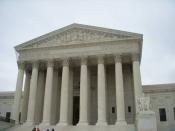Outline and Briefly Explain the Federal Court System
The U.S. has a dual court structure. To be exact, we have a federal judiciary system and the systems that are operated by each of the states. This dual court structure is a unique feature of the American judicial system. Although most cases are tried in state courts, the federal court is playing a larger and larger role in finding resolutions to disputes. Partly, this is because congress in recent years has enacted a range of new laws that grant citizens access to federal courts.
Most of the nation's litigation, as I've said before occurs at state level. When a person has a grievance, he or she can be assured that there is a state court that will consider his case. Although federal courts play an increasing role in the whole litigation picture, they are limited as to the cases over which they can exercise jurisdiction.
In order for a federal court to exercise jurisdiction over a case one of the following conditions must be met: Either there must be diversity of citizenship, or the case must involve a federal question. Diversity of citizenship, by the way, refers to a dispute involving citizens of different states, or a government or citizen of another country. The amount in question, in order for diversity to be applied, must be at least $75,000. That is even though a case may involve citizens of different states, the plaintiff must claim at least $75,000 in damages in order for a federal court to hear the case. For example, a very common case in federal court involves product liability. Suppose someone from Glen Ellyn is injured by a product manufactured in Michigan. Although there is no federal law governing product liability, this would be normally a matter for...


